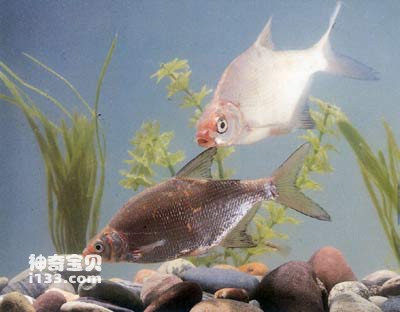The Oriental bream (Abramis brama orientalis) belongs to the order Cypriniformes, family Cyprinidae, subfamily Brama, and genus Abramis. Commonly known as: bream, bream flower. English name: European bream.
The body is tall, oval, and even laterally flattened. The abdomen has ventral ribs from the base of the pelvic fin to the anus, and the caudal peduncle is short and high. The head is small, the snout is blunt, and the eyes are medium-sized. The mouth is in the anterior position, the cleft is small and horseshoe-shaped, and the back end of the maxilla extends below the anterior nostril. No beard, medium-large scales, complete lateral lines; there is one axillary scale at the base of the pelvic fin, the dorsal fin is high, there are no hard spines, the dorsal fin is slightly concave, the base of the anal fin is long, and the pectoral fin does not reach or exceeds the starting point of the pelvic fin. The back of the body is bluish gray, the sides of the body are silver gray, the abdomen is silver white, and the anal fin, pelvic fin and tail fin are black.

The Oriental bream likes to inhabit the slow flow or still water of rivers and lakes, and has strong salt and alkali tolerance. It can grow and reproduce in various waters with a lake water salinity of 0.42-3.43 g/L and a pH value of 8.5-9.0. It is also resistant to hypoxia and will not die when the dissolved oxygen in the water is 0.5 mg/L. The optimum temperature for growth is 17-24°C. Adult fish are larger, generally 30-50 cm in length and 0.5-2.5 kg in weight. It reaches sexual maturity at the age of 4-5, when the body length is 32-37 cm and the weight is about 1 kg. The reproductive period is from late May to mid-June, and the spawning grounds are in shallow water with lush aquatic grasses in Lake Bay Harbor or in secluded areas around the mouth of the river where water flows. The water temperature for spawning is 12-24°C, and the eggs adhere to aquatic plants. The hatched juveniles inhabit and feed in aquatic plants along the coast; the adult fish inhabit and feed near the shore; they disperse in summer and overwinter in groups in deep water in winter. The Oriental bream is an omnivorous fish that feeds mainly on cladocerans, copepods, chironomid larvae, aquatic insects and larvae, oligochaetes, small molluscs with thin shells, and sometimes filamentous algae and tender leaves of higher aquatic plants. Stems, leaves and seeds.
The Oriental bream is native to Europe, so it is also called the European bream. In the 1960s, it was transplanted to the Kasli Lakes and Iset River systems in Russia, and gradually spread eastward into the Ob River Basin. Transplanted to Lake Balkhash in Central Asia in 1949. As the Ili River in Xinjiang flows westward into Lake Balkhash and the Irtysh River flows into the Ob River, the Oriental bream moved up the river and entered the Yi and E rivers in Xinjiang one after another from 1963 to 1965. It was transplanted to Fuhai Lake in 1968 and transplanted to various places in the Xianquan Autonomous Region in 1979. In recent years, Oriental bream has been cultured in large quantities throughout Xinjiang, ranking second after carp in the Ili River's catches, and accounting for 3-5% of the total catches in the Irtysh River and Fuhai. .
The meat of Oriental European bream is thick, tender and delicious, no less than that of bream and bream. It is an excellent species with high edible value. Due to its fast growth, miscellaneous food habits, resistance to cold, salt, alkali and hypoxia, it is extremely suitable for the water environment in northern my country and may become one of the main breeding species in northern my country.
animal tags:
We created this article in conjunction with AI technology, then made sure it was fact-checked and edited by a Animals Top editor.